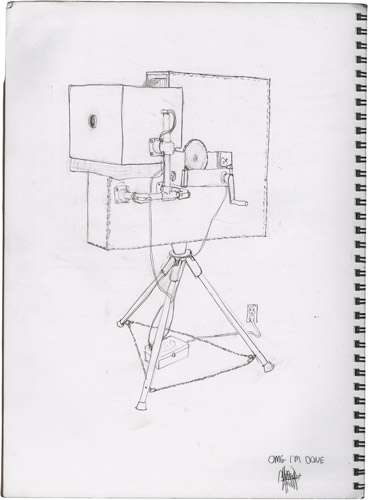Why I Made a Mutoscope (design rationale)
There are many reasons to love mutoscopes, from nostalgia to mechanical beauty, but any expensive niche medium competing with less expensive and widely available systems must have a design rationale and purpose in it’s own right beyond the purely aesthetic. Within the context of the art world mutoscopes have a place as more than a curiosity- they are a solution to a real problem facing animators like Fernando.
Fernando Renes is an animator but his drawings don’t move. All of his animations are digital movies of static drawings one degree removed from his works on paper. If you want to see his work, you’ll have to go to a gallery or museum showing them, because Fernando’s income is dependent on the sales of limited editions his animations. He can’t just post a video to YouTube, it would devalue the work of his collectors. Online and in print there are plenty of stills from his work, but you can’t see any reproduction of his finished pieces anywhere outside of a gallery.
This is problematic for Fernando and other animators in the fine art world, as well as for the art world in general. Painters can be known by their prints- I don’t have to fly to Paris to have seen the Mona Lisa- because prints don’t devalue the originals. But animators’ drawings don’t move, only the movies of their drawings do (Harry Smith, Stan Brackage, and other film scratchers excepted). The “original” is always a print, and the number of prints must be severely limited to control their value so the artist can make a living.
Animators are therefore marginalized within the fine art world. Their work is the hardest to see, so fewer people know of them than artists in other media. Critics, students, and art lovers can’t sit with the work and come to know it they way they can when good prints exist. As a result, the entire field lacks a sense of history and development.
Large-scale mutoscopes can address this problem for Fernando and other animators that draw animations frame by frame. A mutoscope is a circular flip book with it’s pages radiating out from a central binding, played in a mechanical player. Traditionally they were used for photo reproduction of short peep show movies. The Mutoscope for Fernando is for original drawings, and so must be substantially larger (4″ x 3″ drawing area) than a traditional mutoscope (1 7/8″ square). The Mutoscope for Fernando can accept reels of original drawings from 500 to 2500 frames in length, or 30 seconds to 3 minutes, playing back at 8-16 frames per second.
By drawing directly into mutoscope reels, Fernando can make his original drawings move, creating an original object bearing his mark as an artist that is also an animation. Since it is an original, “prints” may be made from it- movies of the machine in action- that have the same relationship that paintings bear to prints. My hope is that mutoscopes can bring the same level of study and distribution to Fernando’s animation that paintings currently enjoy, strengthening the art world and widening his audience.

